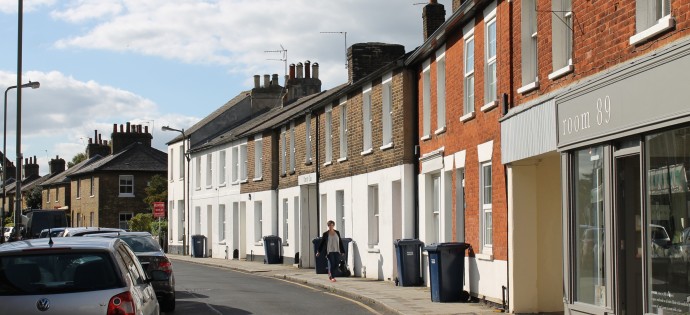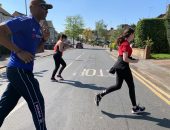The recent changes to Union Street with newer shops like Room 89 and the construction of New Ground Older Women’s Cohousing reminds us how this modest and somewhat overlooked old thoroughfare offers an interesting glimpse of Barnet’s past.
Strolling along from the High Street the old shop fronts, commercial premises and handful of businesses lining the top end of modern day Union Street suggest it has seen busier and more significant times. This is further confirmed as you pass the old town hall about half way along on the left at number 29 (currently enveloped in tarpaulin due to building works). Continuing along the road past the modern Roman Catholic church set back on the right and then a little parade of (empty) shops on the left just before the junction with Stapylton Road on the right and Coe’s Alley tucked round to the left. Union Street comes to an end at the rear of the Black Horse pub. The street also features a range of attractive cottages, some dating back to the early 19th century and the almshouses and gardens, Leathersellers Close, at the junction with The Avenue. Currently there’s a lot of construction work going on which will have a big impact on the street.
Union Street dates from 1837 and was originally called Hartshorn Street after the Hartshorn pub on the corner of the High Street, but it gradually became known as Union Street because it was the main route to the Barnet Union Workhouse from the High Street. The Barnet Poor Law Union (of ten parishes) was formed in July 1835 to collectively finance workhouses and, in 1837, a new workhouse was built on Barnet Common at the end of West End Lane, backing on to Well House Lane. The workhouse closed in 1939, but the infirmary wing continued to be used, evolving into what is now Barnet General Hospital.
The Barnet workhouse is said to have been the inspiration for the workhouse in the Charles Dickens novel Oliver Twist apparently after a friend of the author paid a visit to the establishment and heard a young boy at dinner asking for more. In 2002 the hospital authorities demolished the workhouse to use the site as a car park.
As Union Street linked the High Street with Wood Street and the workhouse, it was a useful bypass for carriages avoiding the narrow junction near the church, “the squeeze”, made more awkward by Middle Row, the little island of shops just south of the church, which was still standing at the time. Union Street started to become important in its own right and its modest scale was in real contrast to Wood Street. Pamela Taylor in Barnet and Hadley Past explains how Union Street “developed into something of a new town centre, with a significant concentration of churches and schools, a meeting room and, from 1889–1912, Barnet Town Hall.”
Archives at the Barnet Museum (Kelly’s Directory of Barnet) reveal a healthy number businesses and services in Union Street in 1891–92: Barnet Free School (number 1), Catholic school (3), decorator (15), cab proprietor (17), curriers (25), Congregational Church Sunday Schools (27), Barnet Town Hall and County Court (29), general shop (33), gardener (43), corn merchant (47), The Black Horse Inn (65); greengrocer (2), tutor (4), boot maker (8), coachbuilder (14), tailors (20 and 48), insurance agent (22), Barnet Young Men’s Christian Association and Literary Institute (38), dairyman (42), plumber (44), accountant (46), baker (58), The Albion Inn (60), printer (62–64), bricklayer (68), tripe dresser (78), mason (82) and the Leathersellers’ Company’s Almshouses.
Nearly 50 years later in 1939 some of the street numbers have changed (eg The Black Horse is at number 75 instead of 65 and The Albion Inn 74 instead of 60), but the range of shops and services was just as broad: Barnet Auction Rooms (number 1a), ironmongers (1), hairdressers (5 and 33), cabinet maker and tailor (23), printers (29–31, the former Town Hall), greengrocers (63), newsagent (73) The Black Horse Inn with garage alongside (75); confectioner (2), laundry (4), sports outfitter (6), boot maker (8), saddler (16), Barnet Conservative and Unionist Working Men’s Club (22), Barnet PSA Brotherhood (50), Barnet Assembly Hall (70), watchmaker (72), The Albion Inn (74), French polisher (76), cake maker (94) and the Leathersellers’ Company’s Almshouses.
The Assembly Hall continued being used as a venue through the 20th century and local residents at the time recall it hosting the Barnet Jazz Club on Tuesdays in the late 1950s and early 60s and even Screaming Lord Sutch and the Savages. The Assembly Hall was demolished around 2000 and The Albion Inn was converted into flats in 2012.
Maybe now that commercial rents are so high on the High Street, businesses are seeking out more modest options. It will be interesting to see if more traders follow Room 89’s example and continue giving Union Street a new lease of life.














In the late 50s I used to go to the jazz club in Union St. I think it was Tuesday evenings and something else on Thursday nights, Acka Bilk, Terry Lightfoot, and Hump. Lyttelton. I can still smell the atmosphere and didn’t that floor bounce?
Great jazz and good memories.
Great sounding memories Tom. Thank you. Humphrey Lyttelton lived nearby in Arkley didn’t he?
My Grandfather, A Pattinson, Electrician was at 33 & 64 Union Street, (opposite Town Hall) and later owned Park Garage in Wood Street. I have a wonderful photo of him outside his shop in Union Street and some letterheaded paper.
Loved reading this article.
i used to live at No 24 with my nan and two uncles, mum and sister. my room was directly above the gate arch to the factory at rear.
Hi Susan,
My mother in law’s family was Foster and Webb, on her dad’s war record his address is 64 Union St, his family were coach builders.
John Dowding
My Grandma and Grandad lived above his barber’s shop in Union Street, next door to Spikesley’s bike shop. After the war, my Mum and Dad, had to squeeze in there too, and then I came along and they were granted a flat in a big house out at Arkley.
We moved round a bit in Barnet, down to Southfields council houses off Mayes Lane, that was great, and I went to Whitehills(?) school. Later we moved back up to Carnarvon Road in town, number 32, with our cousins the Hurleys next door at 30.
When I went on to QEGS my friends and I used to go to the Jazz club in Union Street, next door to the Catholic Church. Humph’s used to be the resident band, if I remember right, and he had all sorts of Trad bands to start with, Chris Barber, Alex Welsh, Acker Bilk etc, but gradually they were able to bring in American bands, more Mainstream and Bebop. Also there was Skiffle and all that sort of thing. It was a great dance floor, packed out! My cousins Janet and Mary went to the Catholic Church, and to the North 20 on the High St. I never learnt to ballroom dance, but they didn’t know what they were missing!
Dear John,
How fascinating – thank you so much for getting in touch.
Very best wishes,
Lucy
There was a Jazz Club called “Club 63” I think,, back in the early 90s.
It was like a secret place…. ou j’allais me decrasser les antennes des mesquineries de la vie.. Oh! Pardon my French. I meant to say… where I would rub-off my antennae from the meanness of life.
Does anyone remember the fancy dress shop called Jester’s?